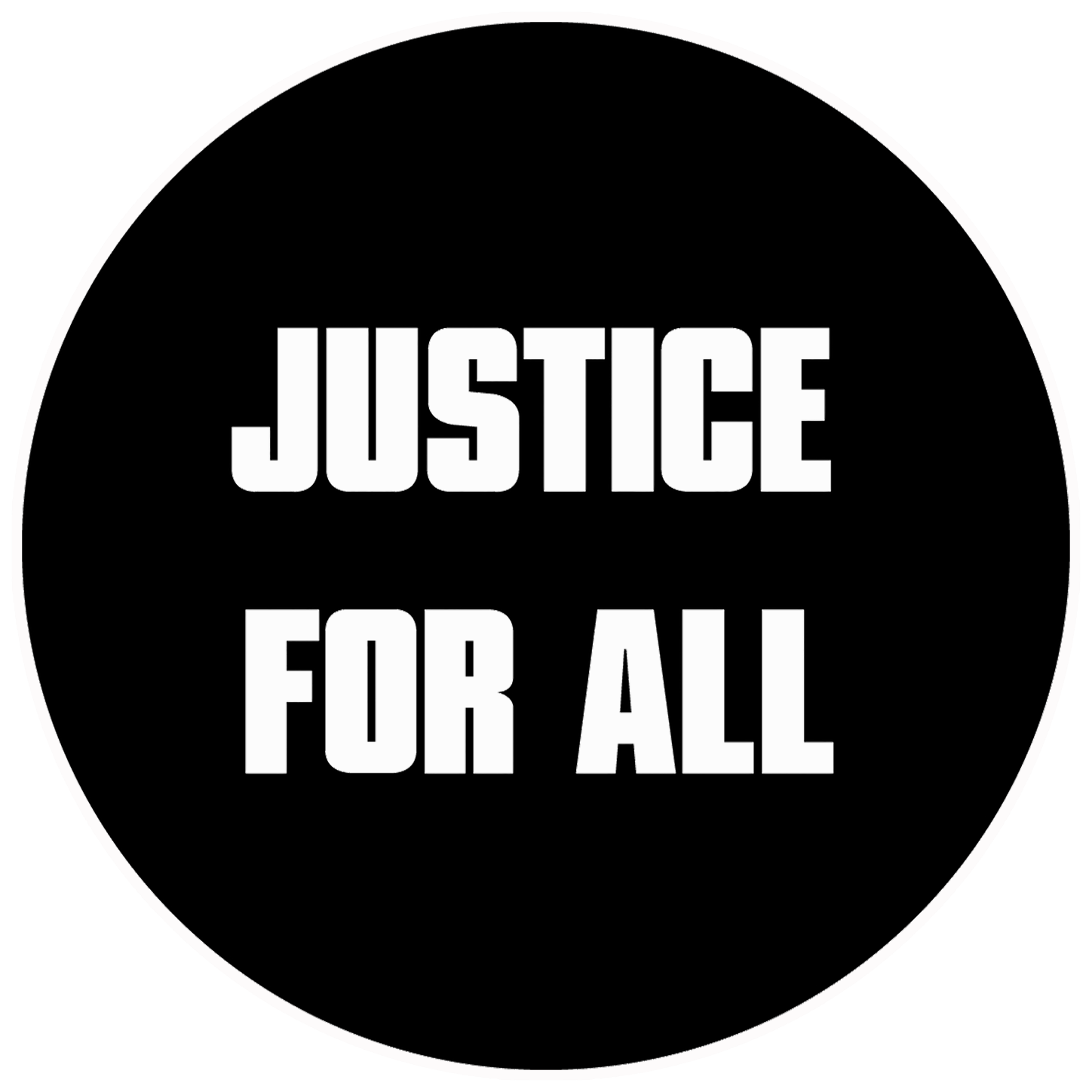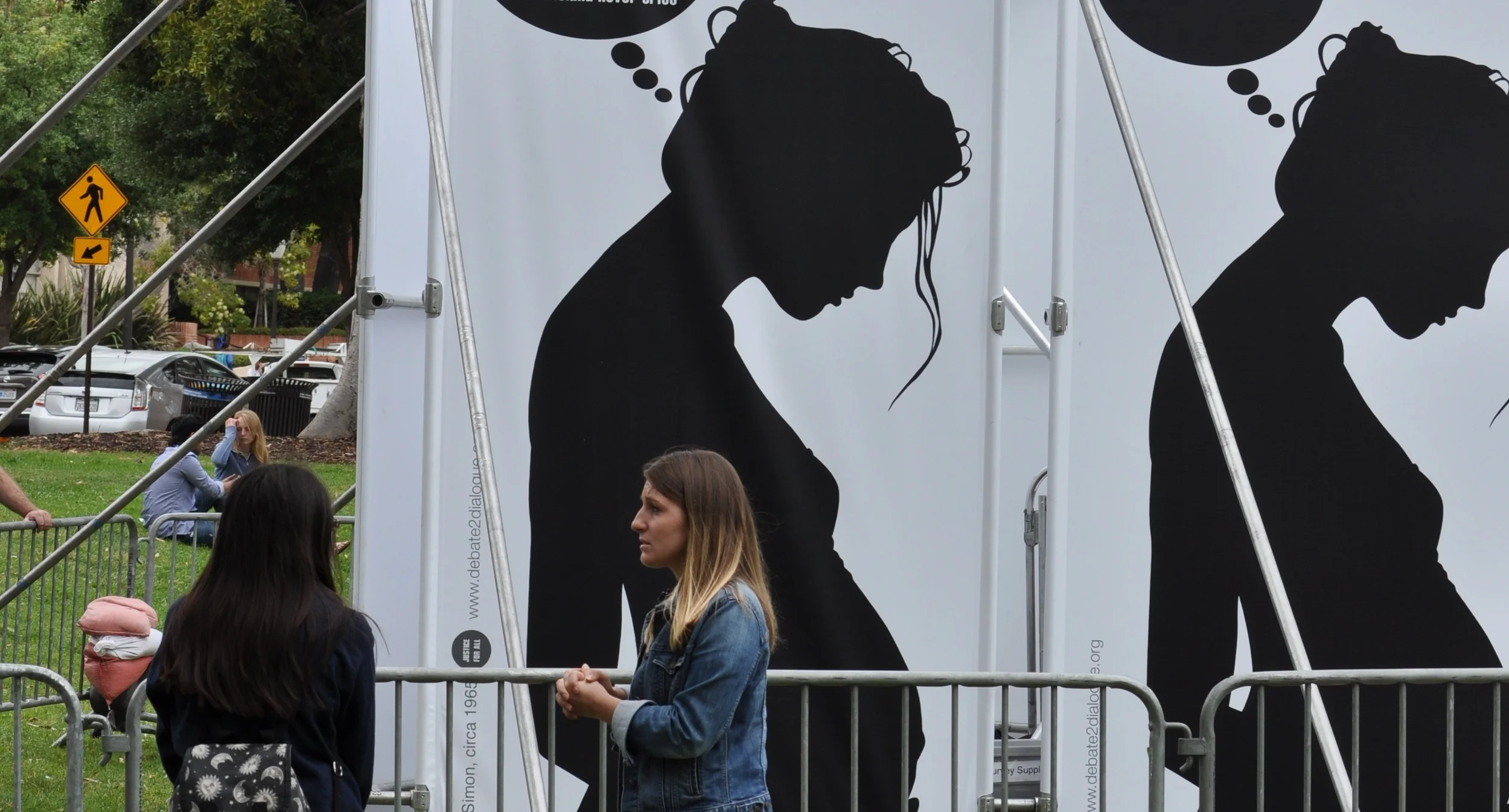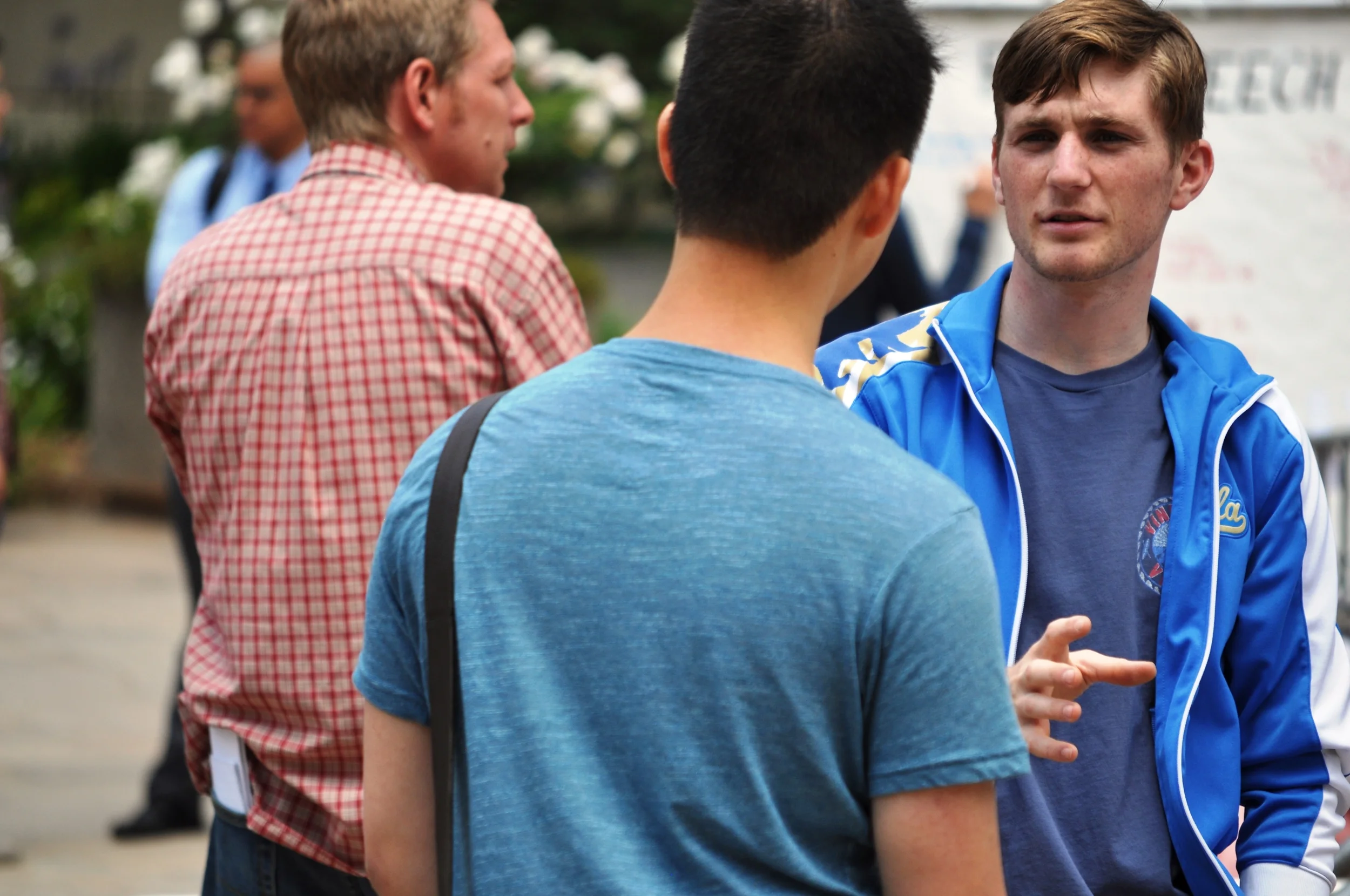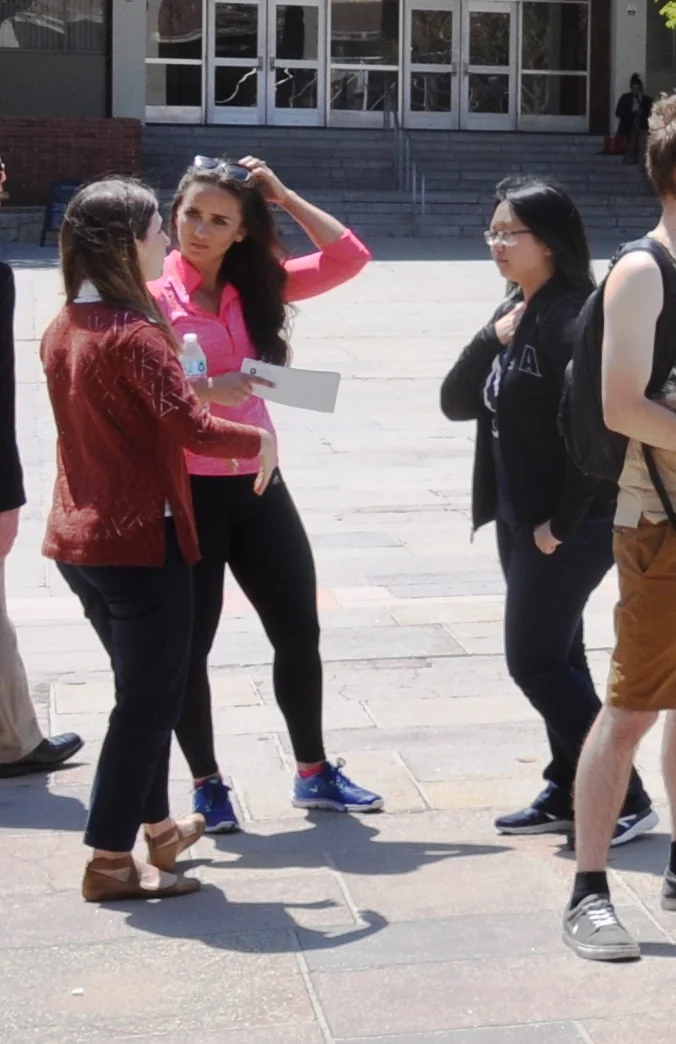August 2016 Impact Report
By Meredith Boles
Introduction by Steve Wagner
INTRODUCTION
In this Impact Report, Meredith Boles describes a conversation that took place at JFA’s new Stop and Think Exhibit (shown below), illustrating how the public display of abortion images, a gracious manner, and thoughtful responses to tough questions can help pro-choice advocates “stop and think” about abortion in a new way.
Meredith and another UCLA student talk in front of JFA's new Stop and Think Exhibit in May 2016.
Meredith also shares what it was like for her club, Live Action UCLA, to partner with JFA to carry out large JFA events on the UCLA campus two years in a row. We cherish the hard work of Meredith, Ines, and other members of their club who share our passion for creating hundreds of conversations about abortion in a single day of outreach. Meredith and Ines helped invite JFA to campus, participated in conversations themselves, and rallied other club members to participate. The result? Together, JFA and Live Action UCLA trained more pro-life advocates and reached more pro-choice advocates than either organization could ever have done on its own.
P.S. This Impact Report is the second in a series showcasing our newly-expanded large exhibit outreach program, which also includes another new exhibit that was displayed at UCLA, The Art of Life. For an introduction to both new exhibits, including more pictures, see JFA’s July report, “Two New Exhibits: A First Look.”
-Steve Wagner, Executive Director
THE STORY
I just graduated from UCLA, and throughout my four years there I was actively involved with the pro-life group. In both my third and fourth years, I coordinated with Justice For All so that we could bring them onto our campus for a training seminar and then for an outreach event. I cannot recommend JFA enough for a club event that is both educational for club members and influential for our peers on campus.
Throughout this past year I had to meet periodically with the staff of the club events office in order to get the training sessions and the outreach exhibits approved, as well as to reserve outdoor spaces, classrooms, equipment, parking, etc. This process was difficult at times because it was very obvious that the campus administration was not pleased with our event, so it felt like I was pulling teeth at times. It was also difficult because not everyone in my club was comfortable with the idea of displaying graphic images of abortion, and so I did not have enthusiastic support from all my club members. But with their consent, and the help of two club members who were fully on board, combined with the guidance and assistance from the JFA staff, and the conviction that this was a great opportunity for my last year in college, we made all of the arrangements.
We had one day of training on a Sunday, and then two days of outreach at two different locations. We needed one club member at all times present at the exhibit, and we used a group chat to coordinate this. All of my club mates told me afterwards that it was a great experience, that they had some tricky conversations, some fruitful conversations, and that by the end they felt much more confident about having these conversations.
Meredith interacts with a fellow UCLA student in front of the side of the Stop and Think Exhibit focused on feminism and women's rights.
I myself had a very good conversation with a student named Amanda. She was walking slowly past Justice For All’s Stop and Think Exhibit when I asked her what she thought of the exhibit. She said she didn’t really understand what it was about, so I offered to walk around it with her and explain it. We walked slowly, side by side. Once we had circled around I asked Amanda what she thought. She replied, “I know it’s a tricky issue. It’s really hard to know. I just think it should be up to the mother. Do you think that abortion should be illegal even if the mother couldn’t afford to have the baby?”
I wasn’t sure if Amanda was expressing this condition because it was her own story. All I could do was express my sympathy for a woman in this situation, whether it was her own or not. I told her I understood her concern – it’s a real one. Students who get pregnant do not just have to put up with expenses for a year. They become permanent mothers. They either need to raise this child, love it, and provide for it, or give it up for adoption. It’s so, so hard for these women on our campus who find themselves pregnant when they did not intend to. Amanda was moved and said, “Yeah, I think adoption is an alternative. People try to say that it’s worse but I think it is a great idea. After all, a lot of couples want a baby.”
I agreed with her and told her there is even a waiting list for couples wanting to adopt. Then I said, “Going back to your concern about women who get pregnant while in poverty. Let me ask you something…” I trotted out the toddler as we had practiced in the training on Sunday, and finished with, “So I know it’s an extreme example, but you wouldn’t say we could kill that toddler, right?” She said, “Of course not,” and then paused and added, “I understand what you mean.”
Her voice got a bit more anxious when she said, “I don’t know, it’s just that this whole time I have been telling myself that I was pro-choice, but after seeing that picture…” She was referring to the picture of the aborted baby on one of the panels of the exhibit. “Is that really ten weeks?” I said yes, and she said, “I had no idea.”
“Working with Justice For All bolstered our club in our fight against abortion, and helped spread awareness of our club. I highly recommend it for every single pro-life group on college campuses.”
I told her that the reality behind that picture is the reason why I am fighting to end abortion. I asked her if she agreed that a procedure so brutal could never be the right option, and so it should not be legal to choose it. She said yes, but asked, “But if abortion were illegal, would that mean women who get abortions would be criminalized? Would you agree with that?” I might have faltered at this point, except that one of the JFA trainers had walked us through this topic at the training. If I truly believe abortion is killing an innocent human being, which I do, then of course a woman who willingly breaks a law that states abortion is an illegal act of murder should be penalized. I told her that it may be the case that a woman who committed an abortion was under a lot of emotional stress, and so may receive less grave sentences, but she would still need to be penalized. She agreed with my reasoning. She said, “Thank you so much for talking to me about this. This really helped me.” I gave Amanda the JFA brochure, and we exchanged numbers. [Editor’s note: See JFA's Extending Your Learning page for more on this topic.]
Not every conversation goes this well, but JFA gives us the tools so that every conversation is at least civil and intelligent, and almost all of them leave the other person pondering. The conversations definitely confirm me in my beliefs; at the same time, talking face-to-face with another student who holds the opposite opinion to mine helps me to be more understanding. It reminds me of the reason why I believe abortion should be illegal: every person, whether it is the pro-choice student who is standing in front of me, or the unborn baby in a mother’s womb, has dignity and ought to be loved.
Working with Justice For All bolstered our club in our fight against abortion, and helped spread awareness of our club. I highly recommend it for every single pro-life group on college campuses.
- Meredith Boles, Member of Live Action UCLA and JFA Volunteer






